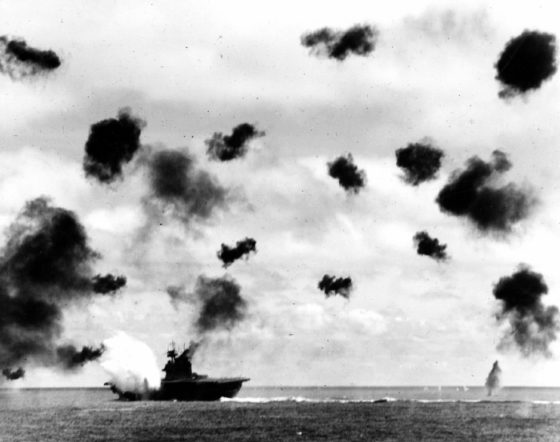
“While conventional wisdom holds that the atomic bombs ended the Pacific War, it was America’s blockade of Japan that brought the empire to its knees.”
By Augustine Kobayashi
WHILE BRITAIN, beleaguered by German U-boats, received much of the spotlight during the Second World War, the United States Navy also waged an anti-shipping campaign, sinking any and all Japanese ships it could with the aim of destroying Tokyo’s war economy. The Battle of the Atlantic was the German attempt to isolate Britain from the United States; the American attempt to isolate Japan from the rest of the world became known as the Battle of the Pacific.
Japan, an island country like Britain, was vulnerable to blockade warfare because of her reliance to imported materials for her industry and food supplies.
In peacetime, Britain supposed that any future conflict with Japan would be a war of economic blockade using the power of the mighty Royal Navy.
For their part, the Americans were more inclined to seek a decisive showdown with the Japanese battle fleet. However, the Japanese attack on Pearl Harbor on Dec. 7, 1941 at least temporarily dashed the prospect of a battleship duel between the two Pacific powers. As a result, the guerre de course became the main battle between Japan and the United States across the Pacific Ocean.
American submarines never enjoyed the notoriety of the Germany’s U-boats. Arguably, the United States’ ‘silent service’ was not as efficient as Hitler’s ‘wolf packs.’ Yet for the Germans, the U-boats were the only weapon capable of seriously threatening Britain; the U.S. would become much more resourceful, using its battle fleets, carrier task forces, strategic bombers, its marines and army divisions, as well as the submarines to take the fight to Japan’s doorstep.
And while conventional wisdom holds that the atomic bombs ended the Pacific War, it was America’s blockade of Japan that brought the empire to its knees.

During the First World War, the U.S. entered the fighting partly because of public outcry over the Germany’s campaign of unrestricted submarine warfare. But that didn’t stop America from using a similar strategy against Japan a generation later.
It must be emphasized that the American submarines were ultimately victorious, unlike their German counterparts; the U.S. strategy was to cut Japan off from its sources of raw materials, fuel and foodstuffs. It is more difficult to measure however how much this campaign actually undermined Japanese morale, as it was the combined effect of submarine warfare, along with strategic bombing and Allied amphibious operations that broke Japan’s spirit. Yet, submarines’ contribution to Japan’s defeat was so great that it is fair to say that the silent service indeed won the battle of the Pacific.
And perhaps they were helped by a lack of effective Japanese counter measures. The Japanese hoped to achieve victory in a speedy conflict, and so had not planned for a lengthy war of attrition in the Pacific. Tokyo was not prepared to think about logistics in general. This neglect proved costly.

During the war, Japan was diplomatically isolated, so her dependence on her overseas possessions, including the recently conquered territories in Southeast Asia, increased. Yet the navy failed to plan for the defence of the shipping lanes between Japan and its colonies. In the end, Japan’s navy ships, with no fuel available for them, were bombed in their home ports by U.S. planes. Tokyo’s desire for a penultimate showdown with big gun battleships (which the Japanese just assumed that they would win) never took place. Their biggest capital ship, the Yamato, in her last desperate mission to seek a glorious battle with the American fleet, exploded after sustained attack by U.S. carrier planes, like buzzing bees bringing down some enormous beast, signalling the end of Japan’s naval predominance in the western Pacific.

BY THE NUMBERS — Statistics about Japanese shipping in WW2
- Japan’s war economy required at least 10 million tons of merchant shipping; at the peak of its power, the empire could muster just 6 million.
- Between December 1941 and August 1945, Japan lost 8.5 million tons of shipping to Allies subs, surface vessels and aircraft.
- Japan managed to replace only 2.5 million tons of lost shipping.
- It is believed that up to 7,000 ships of all types, including fishing boats and barges, were lost, of which 2,500 were ships over 500 tons.
- By March 1945, oil imports to Japan had virtually stopped.
- Almost 50 per cent of Japanese civilian sailors who operated in war zones were killed. The comparative figure for Japanese military was only about 20 per cent.
- In all, 230,000 Japanese perished at sea in World War Two, including 170,000 ‘passengers’, that is, army troops being transported and civilian evacuees.
 Augustine Kobayashi was born in Tokyo, Japan and has studied in Leeds and London, obtaining postgraduate degrees in modern international history and Byzantine history. His interests include naval history in general, Late Roman and Byzantine history, and history of Christianity. His book Japan’s Pacific War is available by Quest Publications.
Augustine Kobayashi was born in Tokyo, Japan and has studied in Leeds and London, obtaining postgraduate degrees in modern international history and Byzantine history. His interests include naval history in general, Late Roman and Byzantine history, and history of Christianity. His book Japan’s Pacific War is available by Quest Publications.










I was certainly hoping for a bit more indepth expose on HOW, meaning discussion of tactics, and particular large scale operations.
U. S. subs operated mainly in groups of 3,then.They used mines,torpedoes & guns.The Japs used barges later in the war.Against those,the subs would use fire guns,instead of launching torpedoes.Their 1st targets were flat tops & their 2nd were merchant ships.